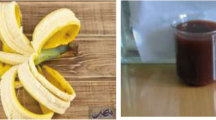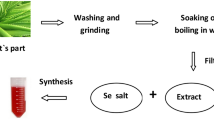Abstract
Stevia is a source of natural sweetener. Numerous researches showed that silver nanoparticles affected the yield and growth of agricultural crops. The effect of silver, graphene, and nanocomposite nanoparticles on a few biochemical and morphological parameters of the Stevia plant were studied. Synthesized Ag nanoparticles were confirmed by the absorption maxima and SEM micrograph. The use of nanocomposites at 40 mM, resulted in the higher chlorophyll content (25%) and increased accumulation of soluble sugars (27%), flavonoids (51%), total phenol (33%) and total protein (51%) as compared to the control plants. The plants treated with nanocomposite at a concentration of 60 mM, had more stevioside and rebaudioside content than plants treated with nanocomposite at a concentration of 40 mM.













Similar content being viewed by others
Abbreviations
- AgNP:
-
Silver nanoparticle
- BSA:
-
Bovine serum albumin
- Chl:
-
Chlorophyll
- IAA:
-
Indole-3-acetic acid
- G:
-
Graphene
- S. rebaudiana :
-
Stevia rebaudiana
- CRD:
-
Completely randomized design
- LSD:
-
Least significant difference
References
Allen MJ, Tung VC, Kaner RB (2009) Honeycomb carbon: a review of graphene. Chem Rev 110:132–145
Arase F, Arase H, Nishitani M, Egusa N, Nishimoto S, Sakurai N, Sakamoto H, Kaminaka I (2012) AA8 involved in lateral root formation interacts with the TIR1 auxin receptor and ARF transcription factors in Arabidopsis. PLoS ONE 7:43–49
Arnon DI (1949) Copper enzymes in isolated chloroplasts. Polyphenoloxidase in Betavulgaris. Plant Physiol 24:1–15
Bradford MM (1976) A rapid and sensitive method for the quantitation of microgram quantities of protein utilizing the principle of protein-dye binding. Anal Biochem 72:248–254
Bujak T, Nizioł-Łukaszewska Z, Gaweł-Bęben K, Seweryn A, Kucharek M, Rybczyńska-Tkaczyk KM (2015) The application of different Stevia rebaudiana leaf extracts in the green synthesi of AgNPs. Geen Chem Lett Rev 3:78–87
Cheng Q, Tang J, Ma J, Zhang H, Shinya N, Qin LC (2011) Graphene and nanostructured MnO2 composite electrodes for supercapacitors. Carbon 49:2917–2925
Daayf F, Ongena M, Boulanger R, Hadrami IE, Belanger RR (2000) Induction of phenolic compounds in two cultivars of cucumber by treatment of healthy and powdery mildew-infected plants with extracts of Reynoutria sachalinensis. J Chem Ecol 26:1579–1593
El-Temsah YS, Joner EJ (2012) Impact of Fe and Ag nanoparticles on seed germination and differences in bioavailability during exposure in aqueous suspension and soil. Environ Toxicol 27:42–49
Geuns JM (2003) Stevioside. Phytochemistry 64(5):913–921
Gomes SIL, Novais SC, Gravato C (2012) Effect of Cu-nanoparticles versus one Cu-salt: analysis of stress biomarkers response in Enchytraeus albidus. Nanotoxicol. 6:134–143
Jain SM, Spencer MM (2006) Biotechnology and mutagenesis in improving ornamental plants in floriculture and ornamental biotechnology. In: Teixeira da Silva JA (ed) Advances and tropical issues. Global Science Book LTD, London, pp 1749–2036
Kim JS, Kuk E, Yu KN (2007) AntimicrobiaL effects of silver nanoparticles. Nanomed 3:95–101
Kumar A, Nirmala V (2004) Gastric antiulcer activity of the leaves of Caesalpinia pulcherrima. Indian J Pharma Sci 66(5):676–678
Larcher W (2010) Expression of ascorbic acid oxidase in zucchini squash (Cucurbita pepo L.). Plant Physiol 96:159–165
Lemus-Mondaca R, Vega-Gálvez A, Zura-Bravo L (2012) Stevia rebaudiana Bertoni, source of a high-potency natural sweetener: a comprehensive review on the biochemical, nutritional and functional aspects. Food Chem 132:1121–1132
Li WR, Xie XB, Shi QS, Duan SS, Ouyang YS, Chen YB (2011) Antibacterial effect of silver nanoparticles on Staphylococcus aureus. Biometals 24:135–141
Majlesi Z, Ramezani M, Gerami M (2018) Investigation on some main glycosides content of stevia rebaudiana under different concentration of commercial and synthesized silver nanoparticle. P B R (1) :1–10
Mamta PR, Vijaylata P, Arvind G, Bikram S, Ravinder KB, Rupinder T (2010) Stimulatory effect of phosphate-solubilizing bacteria on plant growth, stevioside and rebaudioside—a contents of Stevia rebaudiana Bertoni. Appli Soil Ecol 46:222–229
Miralles P, Church TL, Harris AT (2012) Toxicity, uptake, and translocation of engineered nanomaterials in vascular plants. Environ Sci Technol 46:9224–9239
Mody VV, Siwale R, Singh A, Mody HR (2010) Introduction to metallic nanoparticles. J Pharm Bioallied Sci 2:281
Moteriya P, Chanda S (2014) Biosynthesis of silver nanoparticles using flower extract of Cassia roxburghii DC and its synergistic antibacterial efficacy. Sci Iran 21(6):2499–2507
Muszynski R, Sager B, Kamat PV (2008) Decorating graphene sheets with gold nanoparticles. J Phys Chem. 112:5263–5266
Nel A, Xia T, Mädler L, Li N (2006) Toxic potential of materials at the nano level. Science 311:622
Ramezani M, Rahmani F, Dehestani A (2017) The effect of potassium phosphite on PR genes expression and the phenylpropanoid pathway in cucumber (Cucumis sativus) plants inoculated with Pseudoperonospora cubensis. Sci Horti J 234:335–343
Rezvani N, Sorooshzadeh A, Farhadi N (2012) Effect of nano-silver on growth of saffron in flooding stress. Int J Biol Biomol Agric Food Biotechnol Eng 6:11–16
Salunke BK, Sawant SS, Kim BS (2014) Potential of Kalopanax septemlobus leaf extract in synthesis of silver nanoparticles for selective inhibition of specific bacterial strain in mixed culture. Appl Biochem Biotechnol 174:587–601
Vecerova K, Vecera Z, Docekal B, Oravec M, Pompeinano A, Triska J (2016) Changes of primary and secondary metabolites in barley plants exposed to CdO nanoparticles. Enviro Pollut 2018:207–218
Yemm EW, Willis AJ (1954) The estimation of carbohydrates in plant extracts by anthrone. Biochemistry 57:508–514
Zhao J, Cao X, Wang Z, Dai Y, Xing B (2017) Mechanistic Understanding toward the toxicity of graphene-family materials to freshwater algae. Water Res 111:18–27
Acknowledgements
This research has been fully supported by Sana Institute of Higher Education.
Author information
Authors and Affiliations
Corresponding authors
Ethics declarations
Conflict of interest
The authors declare that have no conflict of interest.
Additional information
Publisher's Note
Springer Nature remains neutral with regard to jurisdictional claims in published maps and institutional affiliations.
Rights and permissions
About this article
Cite this article
Nokandeh, S., Ramezani, M. & Gerami, M. The physiological and biochemical responses to engineered green graphene/metal nanocomposites in Stevia rebaudiana. J. Plant Biochem. Biotechnol. 30, 579–585 (2021). https://doi.org/10.1007/s13562-020-00630-4
Received:
Accepted:
Published:
Issue Date:
DOI: https://doi.org/10.1007/s13562-020-00630-4




